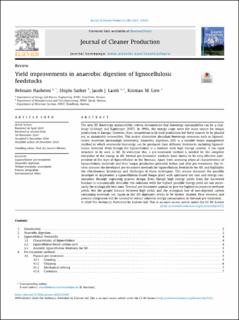| dc.contributor.author | Hashemi, Sayedbehnam | |
| dc.contributor.author | Sarker, Shiplu | |
| dc.contributor.author | Lamb, Jacob Joseph | |
| dc.contributor.author | Lien, Kristian Myklebust | |
| dc.date.accessioned | 2021-01-05T08:51:03Z | |
| dc.date.available | 2021-01-05T08:51:03Z | |
| dc.date.created | 2021-01-04T11:14:39Z | |
| dc.date.issued | 2020 | |
| dc.identifier.issn | 0959-6526 | |
| dc.identifier.uri | https://hdl.handle.net/11250/2721380 | |
| dc.description.abstract | The new EU bioenergy sustainability criteria demonstrate that bioenergy sustainability can be a challenge (Schlegel and Kaphengst, 2007). In 1990s, the energy crops were the main source for biogas production in Europa; however, their competition with food production led these sources to be phased out as sustainable renewables. This makes alternative abundant bioenergy resources such as lignocellulosic materials increasingly interesting. Anaerobic digestion (AD) is a suitable waste management method in which renewable bioenergy can be produced from different feedstocks including lignocellulosic material. Even though the lignocellulose is a biomass with high energy content, it has rigid structure to be used in AD. To overcome this, a pre-treatment method is needed for the complete extraction of the energy in AD. Several pre-treatment methods have shown to be very effective independent of the type of lignocellulose in the biomass. Apart from assessing physical characteristics of lignocellulosic materials and their biogas production potential before and after pre-treatment, this review assesses the developed pre-treatment methods for lignocellulosic feedstocks for AD, and highlights the effectiveness, limitations and challenges of these techniques. This review discusses the possible strategies to implement a lignocellulosic-based biogas plant with optimised net cost and energy consumption through improving process design. Even though high energy yields from the harvested biomass is economically desirable, the solutions with the highest possible energy yield are not necessarily the ecologically best ones. Thermal pre-treatment appears to give the highest increases in methane yields, but the proper balance between high yields and the ecological fate of non-digested carbon containing materials (i.e. lignin in the AD digestate) needs to be further studied. Heat recovery and process integration will be needed to reduce inherent energy consumption in thermal pre-treatment | en_US |
| dc.language.iso | eng | en_US |
| dc.publisher | Elsevier | en_US |
| dc.rights | Navngivelse 4.0 Internasjonal | * |
| dc.rights.uri | http://creativecommons.org/licenses/by/4.0/deed.no | * |
| dc.title | Yield improvements in anaerobic digestion of lignocellulosic feedstocks | en_US |
| dc.type | Peer reviewed | en_US |
| dc.type | Journal article | en_US |
| dc.description.version | publishedVersion | en_US |
| dc.source.volume | 288 | en_US |
| dc.source.journal | Journal of Cleaner Production | en_US |
| dc.identifier.doi | https://doi.org/10.1016/j.jclepro.2020.125447 | |
| dc.identifier.cristin | 1864649 | |
| dc.description.localcode | https://doi.org/10.1016/j.jclepro.2020.125447 0959-6526/© 2020 The Author(s). Published by Elsevier Ltd. This is an open access article under the CC BY license (http://creativecommons.org/licenses/by/4.0/) | en_US |
| cristin.ispublished | true | |
| cristin.fulltext | original | |
| cristin.qualitycode | 2 | |

